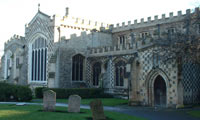Luton's Heritage

Luton has a heritage of monuments and buildings from a wide range of historical periods.
The earliest monuments lie in the north of the borough where earthworks at Waulud's Bank date back to the Neolithic period (c.2500-2000 BC), and those at Dray's Ditches date back to Bronze and Iron Age times. Both are related to the ancient route of Icknield Way, and are protected as scheduled ancient monuments.
St Mary's parish church is the earliest surviving building which is 850 years old and listed grade II, further information on St Mary's can be found further down this page. The Moat House at Biscot is worth a visit as a picturesque thatched restaurant which retains its original moat, is also 14th century.
Luton's first major period of growth was in the 19th century and resulted from the expansion of the hat industry which has left an interesting and often attractive legacy of factories and warehouses, many of which are now loft-style apartments.
The 19th century also saw the building of many churches and chapels (nonconformist thinking was strong in the town), some fine terraced housing (notably in Wellington Street, King Street, George Street West and Park Street West) and individual mansions such as the one now occupied by Luton Museum.
The architectural legacy of the 20th century includes two fine arts and crafts water towers and a wealth of interesting 1930s buildings, including the town hall, churches, cinemas and private houses.
History of Luton
Luton's location on the river Lea and close by the Roman's Icknield Way was the key to its early success.
By the time of the Domesday survey in 1086 Loitone was a well established town of 700 people.
Our farms supported the early malting and brewing industry. Straw plaiting was established in the late 1600s and laid the basis for the hat industry, which expanded rapidly during the 19th century.
In the 1900s engineering and car manufacturing came to Luton. By the great depression between the wars Luton was a boom town, attracting workers from all over the British Isles.
After the Second World, the growth of the airport added to Luton's prosperity and by the time the M1 was constructed in 1960 Luton was without doubt a hugely successful town - which it remains today.
Why not visit Stockwood Discovery Centre and Wardown Park museum to find out more about our history?
St. Mary's Parish Church
 Located in the heart of 21st century Luton, everyone can be inspired by the beauty of the 850 year old building. People have been worshipping on the St Mary's site for over 1000 years. In every generation the church has been extended and developed, retaining a place at the heart of its community.
Located in the heart of 21st century Luton, everyone can be inspired by the beauty of the 850 year old building. People have been worshipping on the St Mary's site for over 1000 years. In every generation the church has been extended and developed, retaining a place at the heart of its community.
The best of the past has been preserved and the best of the new introduced and the church is ready to face the future. In the last ten years alone, the heating system has been restored, the pulpit moved back to its original position and new seating and video projection screens installed.